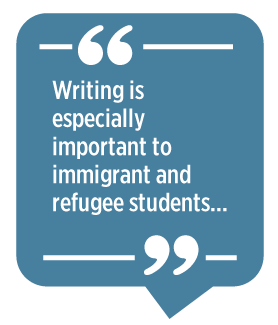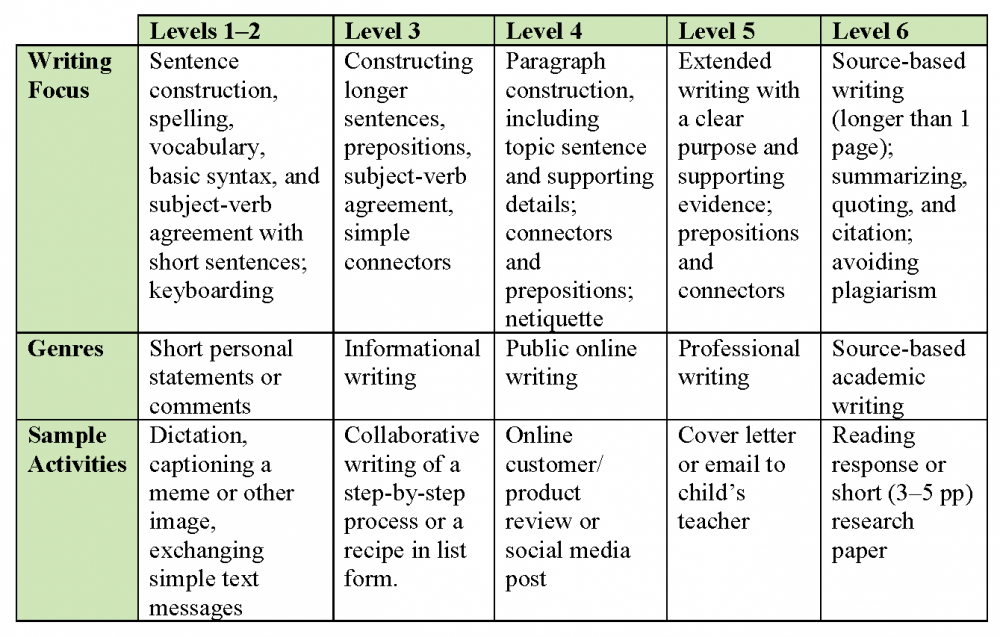Adult Learners in SLW (Part 1): Content-Based Instruction
by Rebeca Fernández

In the digital age, writing has become a routine
aspect of social, educational, and workplace communications. Consider a call
center worker or the attendant at a car repair shop, whose job can entail
reporting on conversations with customers or describing repair work,
respectively, into a computer database. For the individual pursuing a job
requiring a 4-year degree, the rhetorical demands and amount of writing are
even greater (Droz & Jacobs, 2019). Yet, for several years, the
National Association of Colleges and Employers’ (2021) Job Outlook
2022 survey of employers has pointed to the gap between employers’
expectations and the proficiency in communication skills, including writing, of
recent college graduates.
Writing is
especially important to immigrant and refugee students, who require it, along
with other English literacy skills, to pursue further education and achieve
economic self-sufficiency in their new country. In the adult English as a
second language (ESL)/English for speakers of other languages (ESOL) programs
that serve them, a focus on writing can support multiple language skills and
modes (Fernandez, 2019) while also facilitating content learning (Manchón,
2011).
Content-Based Instruction in Adult Education
Content-based instruction (CBI) is a
pedagogical approach to second language teaching characterized by the following
(Brinton et al., 2003):
-
Language is learned as part of
a content area course, unit, or lesson.
-
The sequence and form of
language learning are dictated by the content.
-
The content is determined
by the academic needs and interests of the learners.
-
Learning builds on
learners’ knowledge, language, and previous learning experiences.
Many non-credit-bearing
adult education program courses rely on some variation of CBI. Although CBI
courses often focus on unpacking class readings or lecture material, such
courses are also rife with robust opportunities for writing (Brinton &
Griner, 2019) that teachers may overlook without quality professional
development on the teaching of writing (Fernández et al. 2017).
 The
following will provide adult ESL instructors with a step-by-step guide for
designing theme-based courses for CBI that expand opportunities for students to
write for different audiences and purposes, while improving their vocabulary,
grammar, speaking, listening, and reading skills. It features an example of a
theme-based CBI course I taught in collaboration with a local history museum
and funded through the English Literacy and Civics (EL/Civics) grant program.
The
following will provide adult ESL instructors with a step-by-step guide for
designing theme-based courses for CBI that expand opportunities for students to
write for different audiences and purposes, while improving their vocabulary,
grammar, speaking, listening, and reading skills. It features an example of a
theme-based CBI course I taught in collaboration with a local history museum
and funded through the English Literacy and Civics (EL/Civics) grant program.
A Quick Guide to Designing a
Writing-Centered Content-Based Instruction Course
Before
delving into design, instructors should know that CBI course development is
often iterative and not set in stone. A general roadmap for teaching and
learning is helpful in the beginning, but components of the course, especially
writing tasks and assignments, may have to be modified or added to address
student needs and interests as they arise. The following questions, though not
necessarily in this order, can help in the early planning stage (adapted from
Brinton et al., 2003):
-
What are the goals for and
expected outcomes of this specific program or course?
-
What approach/model/format
will you use?
-
Who are the learners, and
what are their needs and interests, now and in the future?
-
What authentic materials
can you find and use?
-
What instructional
strategies will you use?
-
How will you know that
course goals are being achieved?
1. Set Student-Centered
Goals, Whenever Possible
Course
topics and goals in U.S. federally funded adult ESL programs are often created
in response to local workforce development needs, assessment targets, and
funding requirements. Although these constraints limit the setting of
student-centered goals in the early stages of planning, adding general writing
goals under communication skills may help set the tone for writing among
students.
➣Real-Life Example
The goals of
the CBI course featured in this article, known colloquially as the “museum
course,” were initially established by my supervisor, the Adult ESL Program
director, who was inspired by Columbia Teachers’ College Museum Education
courses. In her grant application, she persuasively argued for the alignment of
EL/Civics objectives and the knowledge of local history, community integration,
and increased parental involvement that students could achieve by partnering
with the Levine Museum of the New South, a local history museum and field trip
destination for the area’s public school students. This rationale became the
basis for the initial course goals. In addition, because students had to demonstrate
progress on the CASAS reading test, the writing goals could be justified from
the beginning.
2. Create a Tentative
Framework in Advance
A CBI
syllabus may be approached in several ways, depending on whether the course is
adjoined or stand-alone. If paired with a credit-bearing content course, the
CBI course may follow that course’s syllabus structure and weekly assignments
to help students meet that course’s objectives. An autonomous, theme-based CBI
course may afford instructors greater flexibility. Syllabi may be organized
around essential questions or topics centered on a common theme and/or a
chronology of events. Language skills and content knowledge can then be shaped
by the materials available, as discussed in the next section.
➣Real-Life Example
I designed the museum course around the Levine Museum of the New South’s permanent exhibit, which documents the history of the region since the Civil War through
a series of dioramas, each the title of a unit theme. To enhance opportunities
to write, each unit included
- a
warm-up writing activity (sometimes done collaboratively or used in a
think-pair-share activity afterwards),
-
an
authentic reading sample,
-
focus-on-form work,
-
discussion topics,
-
an
extended writing prompt, and
-
practice CASAS test
questions (see Table 1).
Table 1.
Sample Syllabus Framework and Unit From the Museum Course

Click here to enlarge.
3. Take Advantage of
Digital Tools to Select and Modify Authentic Materials
Authentic
materials allow adult ESL students, who are often isolated by language and
other social barriers, to interact with real-world discourses in meaningful
ways (Roberts & Cooke, 2009). In the writing-enhanced CBI classroom,
authentic materials accessed on the internet can become the basis for rich
conversations and a springboard to writing, provided they are scaffolded
sufficiently for students. With the help of digital tools, hyperlinking,
glossing, translating, or adding images can make materials more accessible and
support the learning of unfamiliar words.

Authentic
texts (e.g., readings, films, podcasts) do not have to be used in their
entirety. A podcast clip can be turned into a meaningful dictation activity,
used to generate discussion and, for more advanced students, as the basis for
extended writing. Students at all levels can also practice writing skills by
captioning videos, memes, or other visual material.
➣Real-Life
Example
In the
museum course, images and excerpts of archival documents worked well as
authentic materials. Students at all levels could describe historical
photographs, however simply, and empathize in writing with the humble lives of
sharecroppers laboring to support their families under harsh conditions.
4. Design Writing Tasks
According to Students’ Learning Needs and Interests
Although
there are six educational functioning levels in adult ESL (National Reporting
System, 2019), most classes are multilevel, even when students enrolled perform
similarly on the placement test. Assessing students informally by asking them
to complete a personal writing task at the start of the course can assist you
in setting individual writing goals for students and planning appropriate
writing tasks and activities. Table 2, compiled from data in a national survey
of adult ESL teachers (Fernández et al., 2017), may also provide a useful
comparison.
Table 2.
Writing Focus of Adult ESL Instructors by Educational Functioning Level With
Related Genres and Sample Activities (Adapted from Fernández et al.,
2017)

Click here to enlarge.
➣Real-Life
Example
Designed for Levels 3 and 4, the museum course’s
writing tasks tended to produce student texts from a few sentences to
two-thirds of a page in length. I used readings, graphic organizers, and
sentence templates to support students at different levels with the tasks.
Assignments were also modified and enriched as students shared their rich funds
of knowledge. For instance, during a discussion about a reading passage about
traditional cotton farming, a group of students who had woven cotton thread
from a young age described the cotton-to-cloth process to the class, prompting
me to modify the writing assignment so that students could apply new vocabulary
(e.g., bud, blossom, boll), demonstrate their content expertise, and expand
their language skills.
5. Assess Student
Progress and Course Goals Through Writing
Writing can
allow you to gauge and document student progress toward their personal and
course goals in ways that are more individualized than standardized listening
or reading tests and avoid the time-induced anxiety of speaking tests. For CBI
writing tasks to align to course goals, you will need to elicit more than
personal writing throughout the course.
As with the
sample unit in Table 1, you may ask students for personal writing as a lesson
warm-up or to make sense of new information. A quick glance at students’
informal writing at the start of a unit or student comments in a collaborative
annotation platform, such as NowComment,
can act as a formative guide for subsequent reading and language instruction.
As the class progresses into the unit theme, asking students to refer to
readings or discussions in extended writing can help you determine whether
progress toward content and language objectives is being made.
To support
learning, these longer drafts will require more attention. Ferris (2019) lists
best practices for responding to student work, among them, meeting individually
with students to focus on priority areas, such as content and organization.
With respect to language, identifying unclear passages may be the most
efficient approach in the first draft (Campbell et al., 2020). During 2- to
3-hour adult ESL classes, you may use class time to read drafts and hold
writing conferences, ideally in a computer lab; because not all students
compose or keyboard at the same rate, you’ll have time to work on meetings with
all students.
Conclusion
Writing-enhanced CBI tacitly
acknowledges that students benefit from participating in multiple forms of
writing. From consolidating word knowledge by handwriting notes from the board,
to practicing listening comprehension through dictation exercises, to
developing rhetorical knowledge by writing paragraphs and essays, writing can
be as much an act of the mind as it is of communication. It can support deep
learning of content and language as well as create a space for students to
gather their thoughts, find community, and advance in their employment or
educational goals.
The next two
parts of this series on adult learners in second language writing explore other
ways that adult ESL/ESOL instructors can incorporate more writing into their
courses. In Part 2, Joy Kreeft Peyton offers strategies for stimulating and
scaffolding student writing at multiple levels. Part 3 by Kirsten Schaetzel
addresses concerns about writing and assessment by guiding instructors on the
use of test prompts to teach academic writing.
References
Brinton, D.,& Griner, B. (2019). Building pathways for writing development in the content areas. In K. Schaetzel, J. K. Peyton, & R. Fernandez (Eds.), Preparing adult English learners to write for college and the workplace (pp. 66–89). University of Michigan Press.
Brinton, D.
M., Snow, M. A., & Wesche, M. (2003). Content-based language
instruction. University of Michigan Press.
Campbell,
S., Fernandez, R., & Koo, K. (2020). Artifacts and their agents. In A.
Frost, S. B. Malley, & J. Kiernan (Eds.), Translingual
dispositions (pp. 33-62). WAC Clearinghouse. https://wac.colostate.edu/docs/books/translingual/chapter2.pdf
Droz, P. W.,
& Jacobs, L. S. (2019). Genre chameleon: Email, professional writing
curriculum, and workplace writing expectations. Technical
Communication, 66(1), 68–92.
Fernández,
R. (2019). Writing as a basis for reading, and so much more. In K. Schaetzel, J. K. Peyton, & R.
Fernandez (Eds.), Preparing adult English learners to write
for college and the workplace (pp. 23–51). University of Michigan
Press.
Fernandez,
R., Peyton, J. K., & Schaetzel, K. (2017, August). A survey of writing
instruction in adult ESL programs: Are teaching practices meeting adult learner
needs? Journal of Research and Practice for Adult Literacy, Secondary,
and Basic Education, 6(2), 5–20. https://static1.squarespace.com/static/55a158b4e4b0796a90f7c371/t/
59782f28e58c62b0e4b701cc/1501048703128/Summer+Journal+
Interactive+FINAL.pdf
Ferris, D.
(2019). Providing feedback on students’ writing. In K. Schaetzel, J. K. Peyton,
& R. Fernandez (Eds.), Preparing adult English learners to
write for college and the workplace (pp. 141–161). University of
Michigan Press.
Manchón, R.
M. (Ed.). (2011). Learning-to-write and writing-to-learn in an
additional language. John Benjamins.
National
Association of Colleges and Employers. (2021, April). Career
readiness: Competencies for a career-ready workforce. https://www.naceweb.org/career-readiness/competencies/career-readiness-defined/
National
Reporting System for Adult Education. (2019, August). Test benchmarks
for educational functioning levels. https://nrsweb.org/resources/test-benchmarks-nrs-educational-functioning-levels-efl-updated-august-2019
Peyton, J.
K. (2019). Designing writing assignments: Using interactive writing and graphic
organizers. In K. Schaetzel, J. K. Peyton, & R. Fernandez (Eds.), Preparing adult English learners to write for college and the
workplace (pp. 94–117). University of Michigan Press
Roberts, C.,
& Cooke, M. (2009). Authenticity in the adult ESOL classroom and
beyond. TESOL Quarterly, 43(4),
620–642.
Rebeca Fernández is associate professor of Writing and Educational Studies and Multilingual Writing Coordinator at Davidson College in North Carolina, USA. Previously, she taught adult ESL at Central Piedmont Community College, where she developed the museum course featured here. She received a doctorate in language and literacy at the Harvard Graduate School of Education.